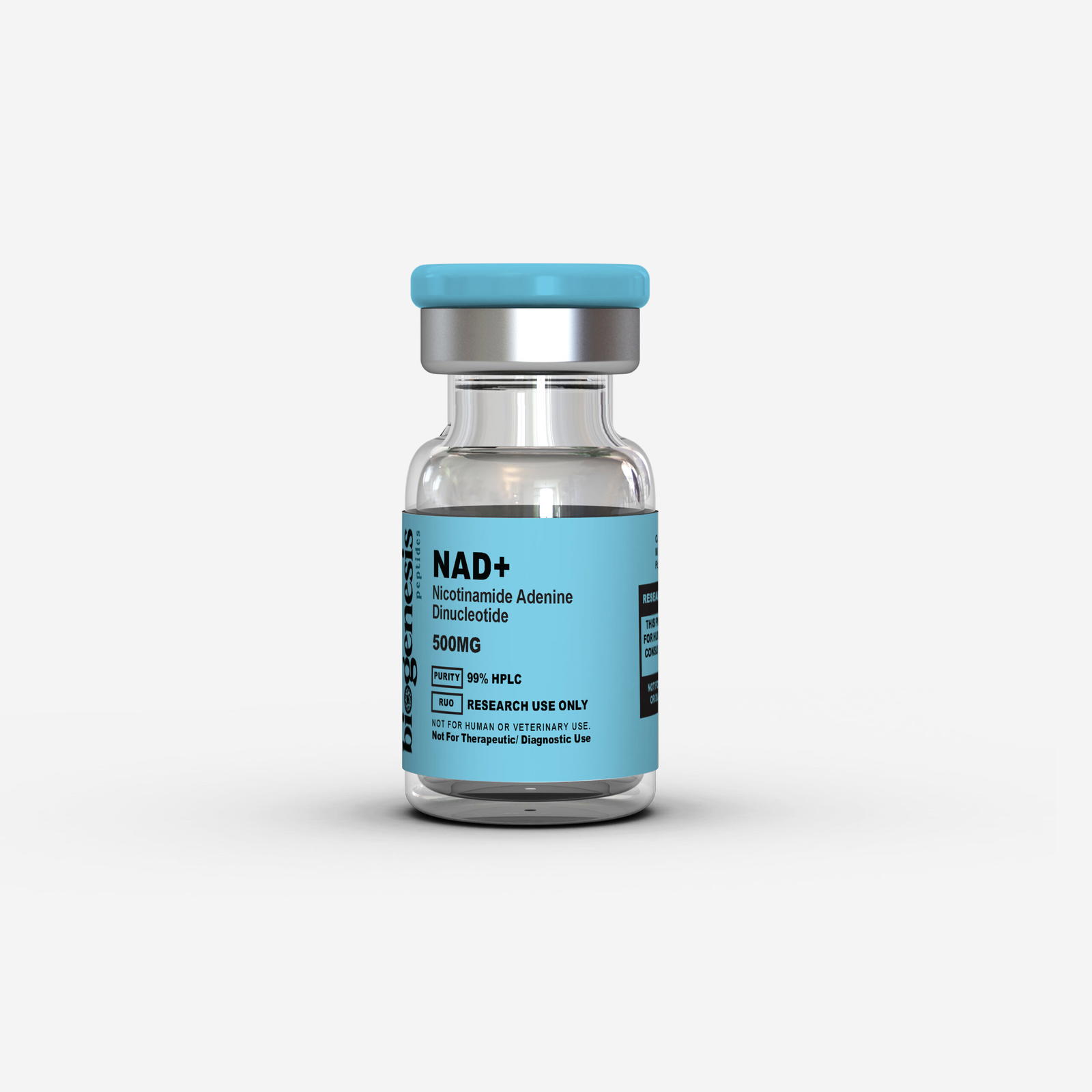Product Usage
THIS PRODUCT IS INTENDED AS A RESEARCH CHEMICAL ONLY. This designation allows the use of research chemicals strictly for in vitro testing and laboratory experimentation only. All product information available on this website is for educational purposes only. Bodily introduction of any kind into humans or animals is strictly forbidden by law. This product should only be handled by licensed, qualified professionals. This product is not a drug, food, or cosmetic and may not be misbranded, misused, or mislabeled as a drug, food, or cosmetic.
NAD+ 500mg
NAD+ (Nicotinamide Adenine Dinucleotide) is a vital coenzyme found in every living cell, essential for energy production, DNA repair, and cellular function. It fluctuates between oxidized (NAD⁺) and reduced (NADH) forms, supporting mitochondrial health and longevity.
$99.00
Peptides will arrive in a lyophilized (powder) form for maximum stability
Buy 5 for 5% off
Buy 10 for 10% off
Buy 15 for 15% off
OVERVIEW
NAD+ (Nicotinamide Adenine Dinucleotide) is a vital coenzyme found in every living cell, essential for energy production, DNA repair, and cellular function. It fluctuates between oxidized (NAD⁺) and reduced (NADH) forms, supporting mitochondrial health and longevity.
Key Benefits of NAD+ Research:
✔️ Boosts mitochondrial energy production
✔️ Supports brain health and cognitive function
✔️ Promotes longevity and cellular repair
✔️ Enhances cardiovascular and metabolic health
✔️ Reduces inflammation and supports immune function
NAD+ is widely studied for its role in aging, neuroprotection, and metabolic disorders.
RESEARCH
1. Mitochondrial Health & Energy Production
- NAD+ is essential for ATP production in mitochondria via the electron transport chain.
- Declining NAD+ levels contribute to mitochondrial dysfunction, leading to fatigue, aging, and metabolic decline.
- Restoring NAD+ improves energy production and reduces oxidative stress.
- Potential application: Anti-aging, energy optimization, and mitochondrial health support.
2. Brain Health & Cognitive Function
- NAD+ activates sirtuins and PGC-1α, key regulators of brain cell repair and neuroprotection.
- It protects neurons from oxidative stress and inflammation, helping prevent Alzheimer’s, Parkinson’s, and cognitive decline.
- Research suggests NAD+ enhances memory, learning, and focus in aging populations.
- Potential application: Brain function, neuroprotection, and cognitive longevity.
3. Longevity & Anti-Aging
- NAD+ activates sirtuins (SIRT1 & SIRT3), enzymes linked to lifespan extension.
- It maintains genomic stability by repairing DNA damage, slowing the aging process.
- NAD+ precursors delay age-related decline in muscle strength and vascular health.
- Potential application: Longevity, anti-aging, and cellular rejuvenation.
4. Cardiovascular & Metabolic Health
- NAD+ supports blood vessel flexibility and prevents atherosclerosis.
- It enhances insulin sensitivity, reducing the risk of Type 2 diabetes.
- Higher NAD+ levels protect against obesity and metabolic syndrome in animal studies.
- Potential application: Heart health, diabetes prevention, and metabolic balance.
5. Inflammation & Immune Support
- NAD+ regulates inflammatory pathways, reducing chronic inflammation linked to metabolic disorders and autoimmune diseases.
- It enhances immune function, helping fight infections and age-related immune decline.
- Potential application: Immune support and inflammation reduction.
6. Addiction Recovery & Mood Regulation
- NAD+ levels are depleted in cases of chronic drug and alcohol use.
- Supplementation has been shown to reduce withdrawal symptoms and cravings.
- Studies suggest NAD+ supports mood stability and resilience against stress.
- Potential application: Addiction recovery and mental wellness.
STRUCTURE
- Molecular Formula: C₂₁H₂₇N₇O₁₄P₂
- Molecular Weight: 663.43 g/mol
- CAS Number: 53-84-9
- Synonyms: Nicotinamide Adenine Dinucleotide, β-NAD, Endopride
CITATIONS
- A. P. Gomes et al. Declining NAD+ disrupts nuclear-mitochondrial communication during aging. Cell (2013).
- S. Imai & L. Guarente. NAD+ and sirtuins in aging and disease. Trends Cell Biol. (2014).
- N. Sun, R. J. Youle & T. Finkel. The mitochondrial basis of aging. Mol. Cell (2016).
- R. T. Matthews et al. Coenzyme Q10 and NAD+ effects on brain mitochondrial function. PNAS (1998).
- C. Shan et al. Protective effects of NAD+ in Parkinson’s disease models. Prog. Neuropsychopharmacol. Biol. Psychiatry (2019).
- D. C. Maddison & F. Giorgini. The kynurenine pathway and neurodegeneration. Semin. Cell Dev. Biol. (2015).
- A. Garten et al. Roles of NAMPT and NAD+ metabolism in health and disease. Nat. Rev. Endocrinol. (2015).
- S. Yamaguchi & J. Yoshino. Adipose tissue NAD+ in obesity and insulin resistance. BioEssays (2017).
- D. Stipp. Beyond Resveratrol: The Anti-Aging NAD+ Fad. Scientific American (2019).
- S. Imai. NAD World 2.0: Systemic Regulation of Aging and Longevity. npj Systems Biology and Applications(2016).
All products on this site are for Research, Development use only. Products are Not for Human consumption of any kind.
The statements made within this website have not been evaluated by the US Food and Drug Administration. The statements and the products of this company are not intended to diagnose, treat, cure or prevent any disease.
Biogenesis Peptides is a chemical supplier. Biogenesis Peptides is not a compounding pharmacy or chemical compounding facility as defined under 503A of the Federal Food, Drug, and Cosmetic act. Biogenesis Peptides is not an outsourcing facility as defined under 503B of the Federal Food, Drug, and Cosmetic act.

